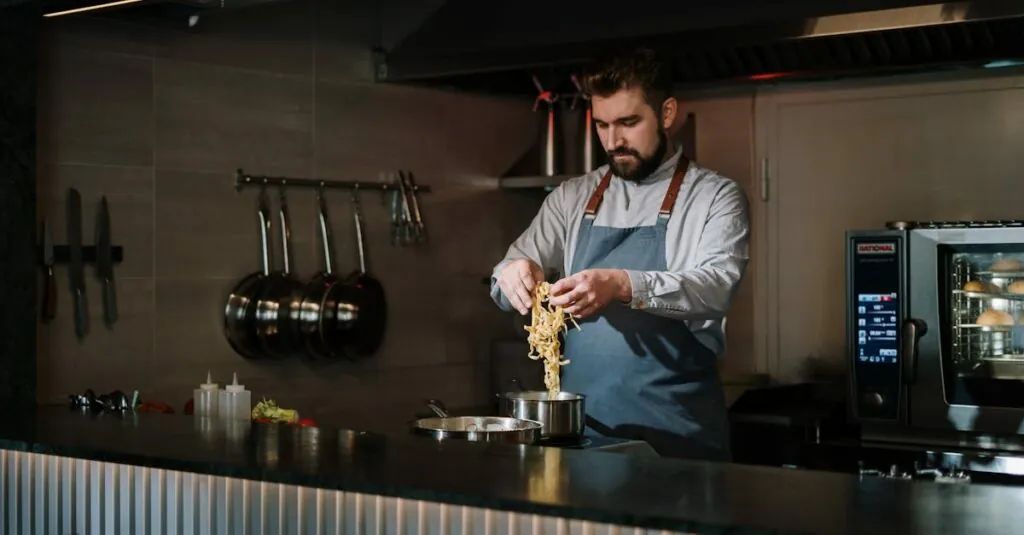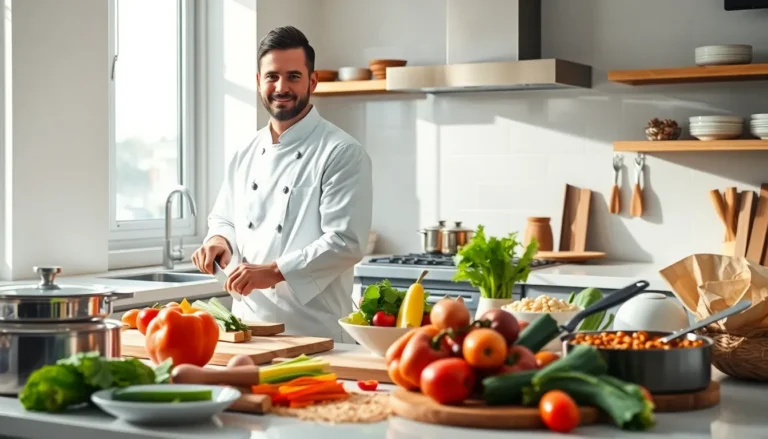Table of Contents
ToggleIn the world of culinary arts, mastering professional cooking techniques can feel like trying to juggle flaming knives while riding a unicycle. But fear not! With the right skills, anyone can transform their kitchen into a gourmet haven. Whether it’s the precision of a julienne cut or the magic of sous-vide cooking, these techniques can elevate any dish from “meh” to “wow!”
Overview Of Professional Cooking Techniques
Mastering professional cooking techniques represents a vital aspect of culinary arts. These techniques enhance flavors, textures, and presentation, leading to exceptional dishes. Techniques like the julienne cut improve the uniformity of vegetable shapes, fostering even cooking.
Sous-vide cooking allows precise temperature control and results in tender, juicy proteins. This method involves sealing food in vacuum bags and cooking it slowly in a water bath. As such, it ensures consistency and enhances flavors significantly.
Braising involves slow cooking in liquid, leading to richer flavors. Chefs often use this method for tough cuts of meat, resulting in tender and flavorful dishes. Sautéing emphasizes the importance of high heat and quick cooking. This technique retains moisture and enhances flavor through caramelization.
Grilling utilizes direct heat from below, making it ideal for imparting charred flavors. Grilled meats and vegetables showcase vibrant colors and rich tastes, appealing to the senses.
Emulsification creates stable mixtures of oil and water-based ingredients. Techniques like whisking or blending allow for smooth dressings and sauces, which elevate any dish.
Incorporating these professional cooking techniques into a kitchen routine equips chefs with the tools needed for culinary excellence. Mastery of these techniques not only improves cooking skills but also distinguishes chefs in a competitive culinary landscape.
Essential Cooking Techniques
Mastering essential cooking techniques elevates culinary skills and enhances meal preparation. Chefs can create gourmet dishes by utilizing foundational methods effectively.
Knife Skills
Knife skills play a crucial role in any culinary endeavor. Proper technique ensures uniform cuts, influencing both appearance and cooking time. Mastering the chef’s knife allows for versatile slicing, dicing, and chopping. Holding the knife correctly prevents accidents and promotes efficiency. Practicing various cuts, such as julienne and brunoise, improves a chef’s precision. Additionally, using the right knife for specific tasks enhances speed and safety. Regular practice builds confidence, making knife skills indispensable in professional kitchens.
Cooking Methods
Understanding different cooking methods is essential for flavor and texture. Techniques such as braising deliver rich, deep flavors through slow cooking in liquid. Sautéing quickly cooks food while preserving moisture, making it ideal for vegetables and proteins. Grilling imparts smoky flavors and beautiful char marks, appealing to the senses. Baking offers precise temperature control, suitable for desserts and bread. Emulsification creates stable sauces and dressings, enhancing dish complexity. By mastering these methods, chefs can expand their culinary repertoire, allowing for creativity and innovation in every meal.
Advanced Cooking Techniques
Advanced cooking techniques elevate meals and refine culinary skills. Mastering these methods leads to extraordinary dining experiences.
Sous Vide Cooking
Sous vide cooking involves sealing food in airtight bags and immersing them in water at precise temperatures. This technique ensures even cooking throughout while preserving moisture and flavor. Chefs often use sous vide for proteins like chicken or steak, achieving tender textures without overcooking. Cooking times can vary from one hour to 48 hours, depending on the desired outcome. After sous vide cooking, a quick sear in a hot pan achieves a perfect crust, enhancing flavor and presentation.
Molecular Gastronomy
Molecular gastronomy combines science with culinary art to transform flavors and textures. Techniques such as spherification create caviar-like beads from liquids, adding a unique element to dishes. Foam and gel innovations enhance presentations and mouthfeel, offering surprising sensations. Chefs employ tools like nitrogen to freeze elements instantly, providing contrasting temperatures in a single dish. Mastering molecular gastronomy requires knowledge of both cooking methods and scientific principles, making it a noteworthy technique for culinary creatives.
Presentation and Plating Techniques
Effective presentation significantly enhances the dining experience. Chefs often use color, texture, and arrangement to create visually appealing dishes. Use complementary colors to attract attention; vibrant green herbs can contrast beautifully against rich sauces.
Plating styles vary widely; some chefs adopt minimalist designs while others prefer elaborate arrangements. Layering ingredients adds depth and dimension to plates. Height can create excitement; stacking elements or using ring molds showcases creativity.
Garnishes should complement the dish without overpowering it. Microgreens or edible flowers often serve as appealing touches, enhancing the overall visual impact. Texture also plays a critical role; pairing crunchy elements with creamy sauces provides a satisfying contrast.
The choice of plates contributes to presentation as well. White plates often highlight colorful food, while darker plates can create a striking backdrop. Consider the shape and size of the dish, as they can dictate the arrangement of food.
Tools such as squeeze bottles allow for precision in creating sauces and drizzles. Applying sauces artistically beside or around ingredients makes the dish look intentional and refined. Using tweezers helps place delicate garnishes with care, emphasizing attention to detail.
Consistency matters in presentation. Chefs regularly aim for uniformity in portion sizes and design elements across dishes. Adhering to these principles can turn any meal into a culinary masterpiece, captivating diners with both flavor and appearance.
Mastering professional cooking techniques opens the door to endless culinary possibilities. Chefs who invest time in honing their skills can transform simple ingredients into extraordinary dishes. Techniques like sous-vide and emulsification not only enhance flavors but also elevate the overall dining experience.
The art of presentation further complements these skills, allowing chefs to create visually stunning meals that captivate diners. With practice and dedication, anyone can learn to juggle these techniques with confidence and creativity. Embracing these methods not only refines culinary abilities but also sets chefs apart in a competitive industry. The journey of mastering cooking techniques is a rewarding one, leading to both personal growth and professional success in the culinary world.



